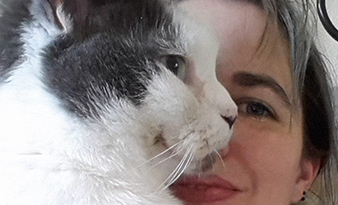What was your first pet?
A Jack Russell Terrier Cross breed called Pip. He was quite feisty, he used to nip us as children if he got fed up.
What is your favourite animal?
My favourite animal is a dog. I have an English Pointer called Goose. He makes me smile everyday and is an excellent running companion.
What is your funniest vet moment?
An owner claimed his cat couldn’t be pregnant as it didn’t go out at night. I had to gently explain that it could happen at any time of day!
What is the most memorable or unusual animal you have treated?
I once anaesthetised a European Brown Bear for root canal surgery.
What is your ultimate veterinary dream?
I think the older I get, the more I appreciate how diverse my job is – managing workflow, dealing with clinical cases, teaching, running a pain clinic etc. The dream is to continue to learn new skills and gain more knowledge and pass that on.
Karla Borland talks about her love of animals and how she became a specialist in Veterinary Anaesthesia and Analgesia.
I have always wanted to be a vet, since I was 3 or 4 years old. My grandparents had a dairy farm next to my house so I spent a lot of time with the calves and cows. We had a menagerie of pets (my parents were very tolerant!) – dogs, cats, rabbits and I almost convinced my mum to adopt a goat!
I managed to get a place at university after school to study veterinary medicine after a lot of hard work. When I finished my degree I went to work as an on-the-road vet in an equine practice in Yorkshire. While there I got involved in anaesthetising horses and wanted to learn more. It was quite a hard decision to leave general practice – the clients and horses in West Yorkshire were great.
I applied for a residency at Edinburgh University and spent 3 and a half years there training to become a veterinary anaesthetist. I now work as a Specialist in Veterinary Anaesthesia and Analgesia at a small animal referral hospital in Hampshire. My daily job involves planning the flow of cases through the hospital (there are over 40 vets so this can be a challenge!), examining cats and dogs prior to anaesthesia and working with our lovely nursing team to implement those anaesthetic plans. Each dog and cat has an individual plan that is tailored to the patient and procedure – it might incorporate an epidural for pain or a specific nerve block. A large portion of my time also involves assessing dogs and cats for pain management – mostly in the hospital but I also see outpatients too. I am passionate about minimising stress and pain in our hospital environment so that the pets can go home as soon as possible and be comfortable and happy.
Find Karla’s profile here

